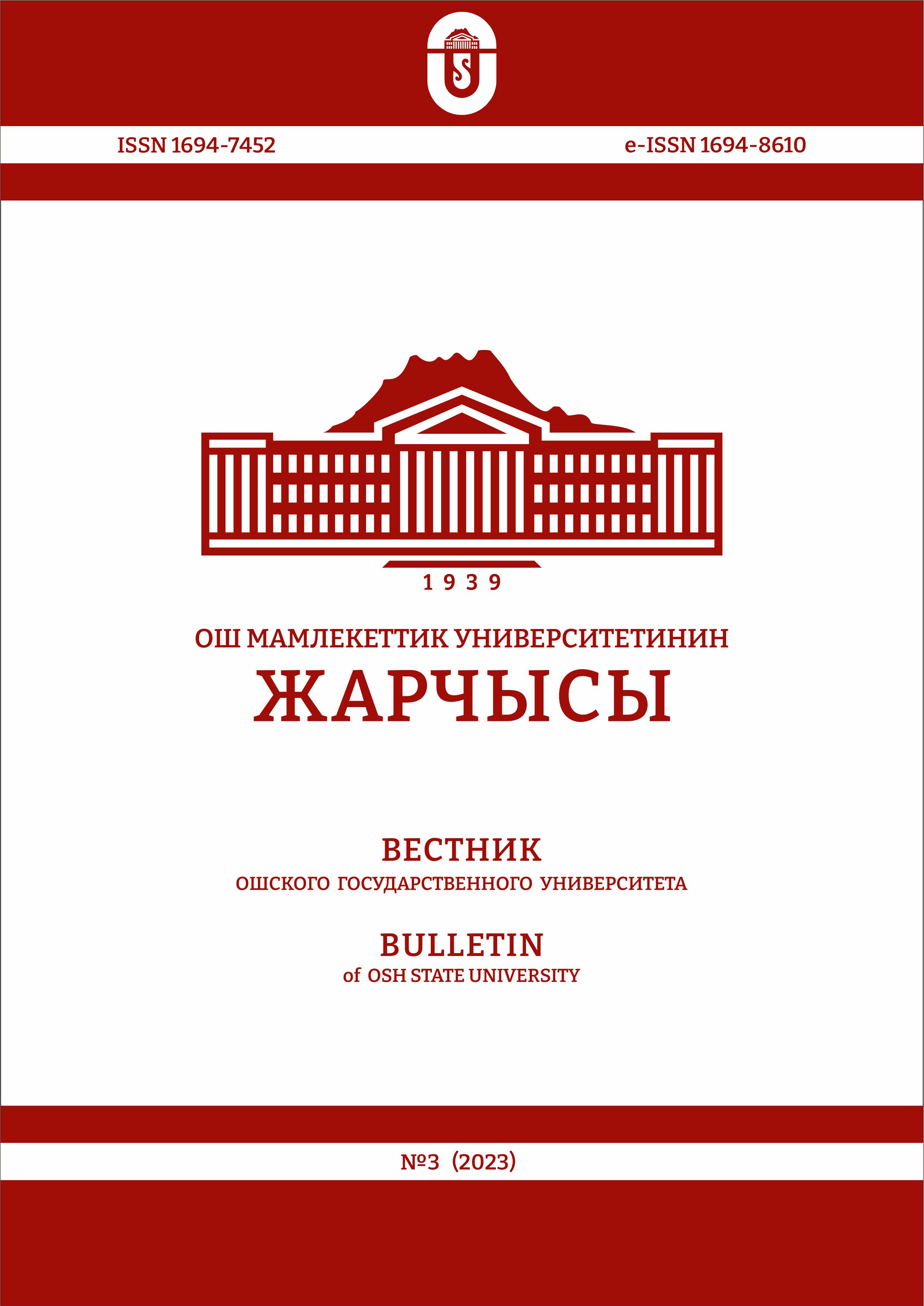ЭЛДИК МЕДИЦИНАДА КОЛДОНУЛГАН ӨСҮМДҮКТӨР ЖӨНҮНДӨ ЧЫНДЫКТАР ЖАНА ТУУРА ЭМЕС ТҮШҮНҮКТӨР
DOI:
https://doi.org/10.52754/16948610_2023_3_1Ачкыч сөздөр:
салттуу медицина, чөптөр, фитотерапия, альтернативдик дары өсүмдүктөрүАннотация
Өсүмдүктөр дүйнөсү жаралгандан бери адамдардын жашоосунда маанилүү орунду ээлеп келет. Өсүмдүктөр ар дайым жашообузда, кээде азык, кээде дары катары колдонулган. Өсүмдүктөр элдин отурукташуусунун негизги себептеринин бири болгон. Адамдар өсүмдүктөрдөн көп шыпаа таап, аларды түрдүү максаттарда да колдонушкан. Масалы, кокустан табылган таксан өсүмдүктөрү бир кезде адамдарды уулантуу үчүн да колдонгон. Мындан тышкары, таксан өсүмдүктөрү бүгүнкү күндө эмчек рагы үчүн эң көп колдонулат. Мурда морфин эң сонун ооруну басаңдатуучу каражат катары колдонулса, бүгүнкү күндө ал эс алуу дары катары да колдонулат. Эң сонун айыктыруучу булак болгон зат да адамдын организмине, өлүмгө чейин олуттуу зыян келтирет. Ошол эле учурда өсүмдүктөр өз максатына ылайык пайдаланылбаса да, аларды туура эмес пайдалануу да адам үчүн терс кесепеттерге алып келет. Мисалы, витекс аялдар үчүн керемет өсүмдүк болсо, эркектер андан алыс болушу керек. Ал эстроген деңгээлин жогорулаткандыктан, аялдарда жакшы натыйжаларды берип, эркектерде тукумсуздукка алып келет. Бул сыяктуу мисалдар санап бүтпөйт. Бул макалада өсүмдүктөрдүн кандай дарылык касиеттерин жана алардын зыянын түшүндүрөбүз. Мындан тышкары, адамдар жашы, жынысы жана оорунун абалына жараша аны кантип колдонуу керектиги жөнүндө маалыматтар берилет.
Библиографиялык шилтемелер
Tauger, M. B. (2020). Agriculture in world history. Routledge. DOI: https://doi.org/10.4324/9780367821739
Zhang, X., & World Health Organization (WHO). (2000). General guidelines for methodologies on research and evaluation of traditional medicine. World Health Organization, 1, 1-71.
Chan, M. (2008, November). Address at the WHO congress on traditional medicine. In World Health Organization congress on Traditional Medicine (Vol. 7).
Siddiqui, S., Khatoon, A., Ahmad, K., Upadhyay, S., Srivastava, A., Trivedi, A., & Arshad, M. (2022). Traditional Islamic herbal medicine and complementary therapies. DOI: https://doi.org/10.5772/intechopen.101927
Spiteri Staines, S. (2011). Herbal medicines: adverse effects and drug-herb interactions.
Bent, S., & Ko, R. (2004). Commonly used herbal medicines in the United States: a review. The American journal of medicine, 116(7), 478-485. DOI: https://doi.org/10.1016/j.amjmed.2003.10.036
Vanherweghem, J. L. (1998). Misuse of herbal remedies: the case of an outbreak of terminal renal failure in Belgium (Chinese herbs nephropathy). The Journal of Alternative and Complementary Medicine, 4(1), 9-13. DOI: https://doi.org/10.1089/acm.1998.4.1-9
Charatan, F. (2002). FDA urged to ban ephedrine from dietary supplements. BMJ: British Medical Journal, 325(7370), 924. DOI: https://doi.org/10.1136/bmj.325.7370.924/e
Ernst, E. (2000). The usage of complementary therapies by dermatological patients: a systematic review. British journal of dermatology, 142(5), 857-861. DOI: https://doi.org/10.1046/j.1365-2133.2000.03463.x
Bedi, M. K., & Shenefelt, P. D. (2002). Herbal therapy in dermatology. Archives of dermatology, 138(2), 232-242. DOI: https://doi.org/10.1001/archderm.138.2.232
Stevensen, C. J. (1998). Aromatherapy in dermatology. Clinics in dermatology, 16(6), 689-694. DOI: https://doi.org/10.1016/S0738-081X(98)00058-3
Ernst, E. (2000). Adverse effects of herbal drugs in dermatology. British Journal of Dermatology, 143(5), 923-929. DOI: https://doi.org/10.1046/j.1365-2133.2000.03822.x
Syed, T. A., Ahmad, S. A., Holt, A. H., Ahmad, S. A., Ahmad, S. H., & Afzal, M. (1996). Management of psoriasis with Aloe vera extract in a hydrophilic cream: a placebo‐controlled, double‐blind study. Tropical Medicine & International Health, 1(4), 505-509. DOI: https://doi.org/10.1046/j.1365-3156.1996.d01-91.x
Algier, L. A., Hanoglu, Z., Özden, G., & Kara, F. (2005). The use of complementary and alternative (non-conventional) medicine in cancer patients in Turkey. European Journal of Oncology Nursing, 9(2), 138-146. DOI: https://doi.org/10.1016/j.ejon.2005.03.010
Coondoo, A., & Chattopadhyay, C. (2013). Drug interactions in dermatology: What the dermatologist should know. Indian journal of dermatology, 58(4), 249. DOI: https://doi.org/10.4103/0019-5154.113928
Reider, N., Issa, A., Hawranek, T., Schuster, C., Aberer, W., Kofler, H., ... & Hausen, B. M. (2005). Absence of contact sensitization to Aloe vera (L.) Burm. f. Contact Dermatitis, 53(6), 332-334. DOI: https://doi.org/10.1111/j.0105-1873.2005.00713.x
Ferreira, M., Teixeira, M., Silva, E., & Selores, M. (2007). Allergic contact dermatitis to Aloe vera. Contact dermatitis, 57(4), 278-279. DOI: https://doi.org/10.1111/j.1600-0536.2007.01118.x
Wohlrab, J., Kreft, B., & Tamke, B. (2011). Skin tolerability of transdermal patches. Expert Opinion on Drug Delivery, 8(7), 939-948. DOI: https://doi.org/10.1517/17425247.2011.574689
Alvarez-Perea, A., García, A. P., Hernández, A. L. R., de Barrio, M., & Baeza, M. L. (2010). Urticaria due to Aloe vera: a new sensitizer?. Annals of Allergy, Asthma & Immunology, 105(5), 404-405. DOI: https://doi.org/10.1016/j.anai.2010.09.016
Pigatto, P., & Guzzi, G. (2005). Aloe linked to thyroid dysfunction. Archives of medical research, 36(5), 608-608. DOI: https://doi.org/10.1016/j.arcmed.2005.03.022
Kriplani, P., Guarve, K., & Baghael, U. S. (2017). Arnica montana L.–a plant of healing. Journal of Pharmacy and Pharmacology, 69(8), 925-945. DOI: https://doi.org/10.1111/jphp.12724
Iannitti, T., Morales-Medina, J. C., Bellavite, P., Rottigni, V., & Palmieri, B. (2016). Effectiveness and safety of Arnica montana in post-surgical setting, pain and inflammation. American journal of therapeutics, 23(1), e184-e197. DOI: https://doi.org/10.1097/MJT.0000000000000036
Sugier, P., Jakubowicz-Gil, J., Sugier, D., Kowalski, R., Gawlik-Dziki, U., Kołodziej, B., & Dziki, D. (2020). Chemical characteristics and anticancer activity of essential oil from Arnica montana L. rhizomes and roots. Molecules, 25(6), 1284. DOI: https://doi.org/10.3390/molecules25061284
Wölbling, R. H., & Leonhardt, K. (1994). Local therapy of herpes simplex with dried extract from Melissa officinalis. Phytomedicine, 1(1), 25-31. DOI: https://doi.org/10.1016/S0944-7113(11)80019-X
Koytchev, R., Alken, R. G., & Dundarov, S. (1999). Balm mint extract (Lo-701) for topical treatment of recurring herpes labialis. Phytomedicine, 6(4), 225-230. DOI: https://doi.org/10.1016/S0944-7113(99)80013-0
Aburjai, T., & Natsheh, F. M. (2003). Plants used in cosmetics. Phytotherapy Research: An International Journal Devoted to Pharmacological and Toxicological Evaluation of Natural Product Derivatives, 17(9), 987-1000. DOI: https://doi.org/10.1002/ptr.1363
Parvez, S., Kang, M., Chung, H. S., Cho, C., Hong, M. C., Shin, M. K., & Bae, H. (2006). Survey and mechanism of skin depigmenting and lightening agents. Phytotherapy Research: An International Journal Devoted to Pharmacological and Toxicological Evaluation of Natural Product Derivatives, 20(11), 921-934. DOI: https://doi.org/10.1002/ptr.1954
Türsen, Ü. (2006). Deri yaşlanmasının topikal ajanlarla önlenmesi. Dermatose, 4, 267-283.
Sharpe, R. M., Martin, B., Morris, K., Greig, I., McKinnell, C., McNeilly, A. S., & Walker, M. (2002). Infant feeding with soy formula milk: effects on the testis and on blood testosterone levels in marmoset monkeys during the period of neonatal testicular activity. Human Reproduction, 17(7), 1692-1703. DOI: https://doi.org/10.1093/humrep/17.7.1692




